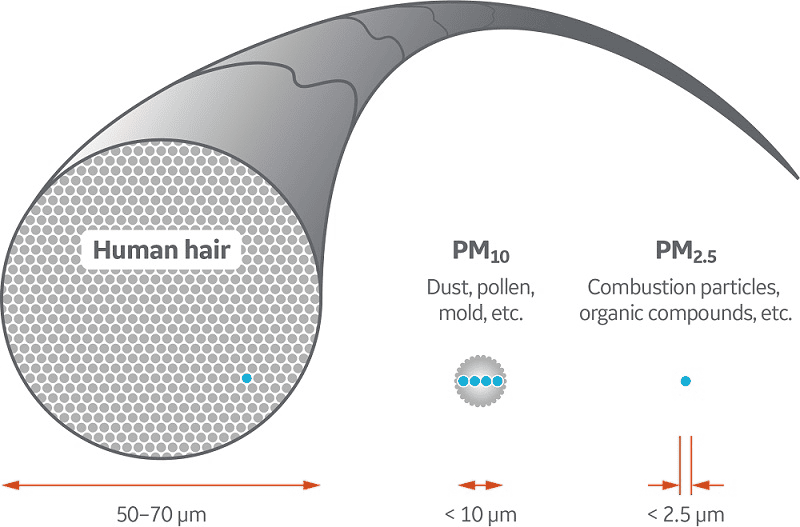





Abstract: Particulate Matter 2.5 (PM2.5) is a significant air pollutant with adverse effects on human health and the environment. This article delves into the characteristics, sources, and impacts of PM2.5 on public health, climate, and ecosystems. It explores the role of regulatory measures, technological advancements, and individual actions in mitigating PM2.5 pollution and promoting cleaner air for a healthier future.
Table of Contents:
Introduction
Characteristics of PM2.5
Sources of PM2.5
Health Effects of PM2.5
PM2.5 and Climate Change
Environmental Impacts of PM2.5
Monitoring and Measurement of PM2.5
PM2.5 Regulations and Standards
Mitigation Strategies for PM2.5 Reduction
The Role of Individuals in Reducing PM2.5 Exposure
Introduction: Particulate Matter 2.5 (PM2.5) is a form of air pollutant that has gained significant attention due to its adverse effects on human health, the environment, and climate change. PM2.5 consists of tiny particles with a diameter of 2.5 micrometers or smaller, making it small enough to penetrate deep into the respiratory system and enter the bloodstream. This article aims to provide a comprehensive overview of PM2.5, including its characteristics, sources, health effects, environmental impacts, monitoring methods, and mitigation strategies. By understanding the complexities surrounding PM2.5 pollution, we can work towards collective efforts to combat this invisible threat and promote cleaner air for a healthier and more sustainable future.
Characteristics of PM2.5: PM2.5 particles are characterized by their size and chemical composition. Due to their small size, they can stay suspended in the air for extended periods, leading to long-range transport and the potential to impact regions far from their original sources. PM2.5 is a complex mixture of organic and inorganic compounds, including black carbon, sulfates, nitrates, metals, and volatile organic compounds (VOCs). The article will also explore factors that influence PM2.5 concentrations, such as meteorological conditions, geographical location, and emission sources.
Sources of PM2.5: PM2.5 originates from various anthropogenic and natural sources. Human activities, including industrial processes, transportation, and residential combustion, are major contributors to PM2.5 emissions. Additionally, natural sources like wildfires, dust storms, and volcanic eruptions release significant amounts of PM2.5 into the atmosphere. The article will examine the primary sources and the role of secondary PM2.5 formation from precursor gases.
Health Effects of PM2.5: PM2.5 is known to have severe health impacts, particularly on the respiratory and cardiovascular systems. Chronic exposure to PM2.5 is linked to increased risks of asthma, chronic obstructive pulmonary disease (COPD), lung cancer, and heart diseases. Vulnerable populations, such as children, the elderly, and individuals with pre-existing health conditions, are more susceptible to the adverse effects of PM2.5. The article will delve into epidemiological studies and scientific evidence linking PM2.5 exposure to various health outcomes.
PM2.5 and Climate Change: Beyond its direct effects on human health, PM2.5 also plays a role in climate change. It affects the Earth’s energy balance through radiative forcing, influencing regional and global climate patterns. The interaction of PM2.5 with clouds and precipitation can further complicate the climate system. The article will explore the relationship between PM2.5 and climate change, emphasizing the importance of considering both air quality and climate policy in addressing these interconnected issues.
Environmental Impacts of PM2.5: The environmental consequences of PM2.5 pollution extend beyond human health and climate. PM2.5 can harm ecosystems, leading to soil and water contamination, damage to vegetation, and negative impacts on biodiversity. The article will examine how PM2.5 affects ecosystems and wildlife, disrupting ecological balance and posing challenges for environmental conservation efforts.
Monitoring and Measurement of PM2.5: Accurate and reliable monitoring of PM2.5 is essential for understanding its spatial and temporal variations, identifying pollution sources, and assessing compliance with air quality standards. The article will discuss various monitoring techniques and instruments used for measuring PM2.5 concentrations, as well as the establishment of national and global monitoring networks. It will also cover data interpretation, validation, and reporting methods.
PM2.5 Regulations and Standards: Governments and international organizations have developed air quality guidelines and standards to regulate PM2.5 concentrations and protect public health. The article will provide an overview of international and national air quality guidelines and explore the challenges in implementing and complying with these regulatory measures. It will also discuss the effectiveness of various policy interventions in reducing PM2.5 pollution.
Mitigation Strategies for PM2.5 Reduction: Addressing PM2.5 pollution requires a multi-faceted approach involving technological solutions, urban planning, and sustainable practices. The article will highlight emission control technologies, air pollution control devices, and the role of renewable energy in reducing PM2.5 emissions. Additionally, it will explore the significance of urban planning, green spaces, and sustainable transportation in curbing PM2.5 pollution in urban areas.
The Role of Individuals in Reducing PM2.5 Exposure: Individual actions also play a crucial role in mitigating PM2.5 exposure. The article will provide practical tips for improving indoor air quality, adopting personal protective measures during high pollution days, and engaging in advocacy and community initiatives to raise awareness about PM2.5 pollution.
Case Studies and Success Stories: The article will present case studies of cities and countries that have successfully reduced PM2.5 levels through comprehensive air quality management strategies. These success stories will offer valuable lessons and best practices for other regions grappling with PM2.5 pollution.
Future Outlook and Challenges: As the world faces increasing urbanization, industrialization, and climate change, the article will examine emerging challenges and trends related to PM2.5 pollution. It will also highlight ongoing research and technological innovations aimed at tackling PM2.5 pollution and promoting cleaner air and healthier environments.
Conclusion: The fight against PM2.5 pollution is a critical aspect of safeguarding human health, preserving ecosystems, and mitigating climate change. With concerted efforts from governments, industries, communities, and individuals, we can make substantial progress in reducing PM2.5 emissions and creating a cleaner and healthier environment for current and future generations. Through sound science, innovative technologies, and collective action, we can tackle the invisible threat of PM2.5 and pave the way for a sustainable and brighter future.




